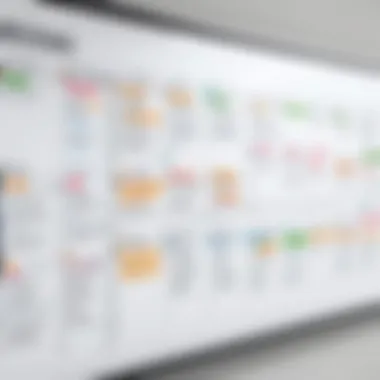Enhancing Team Collaboration with Whiteboards


Intro
Collaboration in teams is vital for achieving goals effectively. Using whiteboards can significantly influence how teams interact and align their objectives. These tools not only facilitate brainstorming but also help in organizing thoughts visually. Understanding the various types of whiteboards and their functionalities offers teams a chance to enhance productivity. In the following sections, we will delve into whiteboard features, user experiences, and how to integrate them into daily workflows.
Overview of Key Features
Whiteboards come in various forms, each with unique capabilities tailored to the needs of teams. Choosing the right one can make a considerable difference in collaborative work. Some essential features to consider include:
- Digital Versus Physical: Teams can choose from traditional whiteboards or advanced digital options that allow for online collaboration, ensuring that remote team members can participate.
- Integration Capabilities: Some whiteboards integrate seamlessly with tools like Slack or Trello, enhancing collaborative efforts and keeping all team members aligned.
- Customization Options: Options such as custom templates and drawing tools provide flexibility to teams for specific projects.
- Real-time Collaboration: Many digital whiteboards enable multiple users to edit simultaneously, fostering immediate feedback and discussion.
In this digital age, real-time collaboration stands out as a crucial feature. It facilitates a dynamic flow of ideas without the constraints of geographical locations.
User Experience
The effectiveness of a whiteboard also hinges on the user experience it provides. A clean interface and straightforward usability are essential for widespread adoption within a team. Here are some aspects to consider:
- Interface and Usability: A simple, intuitive design helps users navigate functions quickly, which is critical during fast-paced brainstorming sessions. Ensuring that team members can easily adapt is key for success.
- Support and Community Resources: Good software may come with resources such as tutorials, FAQs, and community support groups. These can assist new users quickly acclimate to the system. For example, platforms like Miro and MURAL have thriving communities on Reddit, offering shared insights and troubleshooting tips.
"Choosing the right whiteboard can enhance not just collaboration, but also the engagement of team members in the process."
Making informed decisions about features and usability can drive higher engagement, benefiting the overall productivity of the team. Thoughtful consideration of user experience makes it easier for teams to achieve consensus and align their goals throughout any project.
Culmination
Aligning team goals is critical to the success of any project. Whiteboards, both digital and physical, offer essential tools that can help facilitate this process. Understanding their key features and ensuring a positive user experience will make it easier for teams to collaborate effectively. By integrating these tools within their workflows, individuals and organizations stand to optimize their efforts, leading to better project management and an increase in innovative ideas.
Prologue to Whiteboards in Team Settings
In contemporary workplaces, the significance of effective communication and collaboration cannot be overstated. Today’s fast-paced environment requires teams to align their goals efficiently to adapt to changes and achieve success. Whiteboards serve as powerful tools that promote this alignment and foster a more engaging workspace. This section outlines why whiteboards are integral in team settings and examines the benefits they offer.
Whiteboards act as central hubs for ideas and information. They allow teams to visualize concepts, strategies, and objectives collaboratively. Using a whiteboard, team members can brainstorm, outline tasks, and create mind maps that clarify their collective goals. This visual representation can enhance understanding among team members, making it easier to track progress and adjust strategies when necessary.
Several benefits stem from utilizing whiteboards in team environments:
- Clarity and Focus: Whiteboards provide a clear platform for displaying tasks and milestones. This encourages team members to concentrate on priorities and align their efforts toward common goals.
- Enhanced Collaboration: The interactive nature of whiteboards fosters participation. When team members gather around a whiteboard, discussions become more dynamic, leading to collaborative problem-solving and innovation.
- Flexibility in Use: Whiteboards can be adapted for various purposes, from brainstorming sessions and daily stand-ups to detailed reporting on project phases. This versatility ensures they remain relevant in diverse contexts.
- Immediate Feedback: Writing or drawing ideas in real time enables instant feedback from colleagues. This can facilitate quicker decision-making and avoid miscommunication.
While whiteboards present numerous advantages, it is essential to consider their implementation thoughtfully. Proper training and rules for usage should be established to maximize their potential. Teams must ensure that the whiteboard remains organized and information is regularly updated to avoid confusion or clutter.
"The ability to visualize shared goals is fundamental to team dynamics."
In summary, whiteboards are more than just tools for writing; they are essential components of collaboration in modern teams. They not only keep teams aligned with their goals but also create an environment conducive to open communication and adaptability. Understanding the role and advantages of whiteboards is the first step toward optimizing their use in the workplace.
The Evolution of Whiteboards for Teams
The evolution of whiteboards for teams reflects a significant shift in how collaborative environments function. Whiteboards have transitioned from a basic tool of communication to a versatile platform for problem-solving and creative thinking. In this article, we explore the profound impact of whiteboards over time and how they align team goals and enhance productivity. Understanding this evolution provides insights into the best practices for choosing and using whiteboards in today’s fast-paced work settings.
Historical Context
Historically, the concept of a whiteboard originated from traditional classroom blackboards. Over the years, these blackboards were replaced with whiteboards, offering better visibility and ease of erasure. In the early stages, whiteboards were mainly used in educational institutions. However, businesses quickly recognized the potential of these boards for fostering collaboration among team members. As teams began to embrace more visual methods of project management, the whiteboard became a staple in meetings and brainstorming sessions, allowing for real-time idea generation. With this historical backdrop, it is clear that the foundation for modern collaboration lies in the simplicity and effectiveness of the whiteboard.
Technological Developments
In recent years, technological developments have propelled whiteboards into new realms. Digital whiteboards have emerged, allowing teams to collaborate virtually, breaking down the barriers of physical locations. Tools like Miro and Microsoft Whiteboard enable real-time interaction, making it possible for team members to contribute simultaneously from different parts of the world.
These advancements have prompted organizations to rethink how they engage their teams. Benefits of technological whiteboards include:
- Improved accessibility of ideas across teams.
- Enhanced ability to store and share information with minimal effort.
- Integration with project management and productivity tools.
The original function of a whiteboard has expanded significantly due to technology, transforming it into a versatile tool that accommodates a variety of needs in collaborative settings. This evolution showcases the critical role that technology plays in shaping team interactions and goal alignment.
Types of Whiteboards for Teams
Understanding the Types of Whiteboards available for teams is crucial for anyone looking to improve collaboration and goal alignment in a team setting. Each type serves unique functions and caters to different needs. Selecting the right whiteboard can lead to enhanced productivity, streamlined communication, and better overall team dynamics. In this section, we will explore three primary types: traditional, digital, and mobile whiteboards.
Traditional Whiteboards
Traditional whiteboards have been a staple in meeting rooms for decades. These surfaces, typically made from materials like melamine or porcelain, are favored for their simplicity and accessibility. One of the primary benefits is their ability to facilitate spontaneous brainstorming sessions. Team members can easily annotate ideas, sketch concepts, or make notes during discussions. This real-time interaction creates an engaging environment which may stimulate creativity.
Key Considerations for Traditional Whiteboards:
- Space Requirements: Proper placement in a workspace is essential. Ensuring visibility for all team members is important for effective collaboration.
- Cleaning and Maintenance: Adjustable markers and erasers are needed. Regular cleaning ensures the board remains clear and usable.
- Durability: High-quality whiteboards can withstand frequent use without significant wear.
Digital Whiteboards
Digital whiteboards represent a significant evolution in collaborative tools. Platforms like Miro and Microsoft Whiteboard allow for asynchronous collaboration. This is particularly advantageous for remote or hybrid teams. Team members can access the board from different locations and contribute at their convenience.
Benefits of Digital Whiteboards:


- Integration: Most digital whiteboards can be integrated with other project management and communication tools, enhancing workflow.
- Versatility: Users can employ various templates, add digital sticky notes, and insert files directly onto the board. This flexibility accommodates different work styles and processes.
- Tracking Changes: Digital platforms often include features for tracking edits, enabling teams to revert to previous versions if needed.
Mobile Whiteboards
Mobile whiteboards offer a unique advantage in settings that require flexibility. These boards, often mounted on casters, can be moved easily between locations. This portability makes them suited for dynamic work environments, such as project kick-offs or cross-team collaborations.
Advantages of Mobile Whiteboards:
- Adaptability: Teams can reconfigure meeting rooms or collaboration spaces to fit their needs.
- Interactive Workshops: Ideal for workshops and training sessions where participants may work in smaller groups.
- Space Optimization: They can be stored away when not in use, minimizing clutter in shared environments.
Ultimately, selecting the right type of whiteboard depends on your team's specific needs, workspace dynamics, and collaboration goals. Each type offers distinct features that can enhance productivity and engagement.
Choosing the Right Whiteboard for Your Team
Choosing the right whiteboard is crucial for fostering effective teamwork and aligning goals. The selection process must take into account various factors such as team dynamics, meeting styles, and specific project requirements. This guide will help navigate these aspects to enhance collaboration where it counts.
Assessing Team Needs
When assessing team needs, it is essential to engage team members in discussions about their preferences and workflows. Different teams have distinct functions which necessitate different approaches to collaboration. For example, a design team might benefit more from a digital whiteboard, while a project management team may find traditional whiteboards more effective for daily stand-ups.
Consider these factors while assessing team needs:
- Size of the Team: A larger team might require a larger surface area, which translates to bigger whiteboards.
- Nature of Projects: Teams engaged in brainstorming may favor a flexible setup that allows free-form interaction.
- Collaboration Style: How often do team members collaborate? Continuous collaborators may prefer digital options that save changes automatically, while occasional users might opt for traditional boards that offer a physical space for notes.
- Physical Space Available: It’s important to evaluate the workspace for compatibility. Does the office layout permit a large board, or would smaller, movable options work better?
By answering these questions, teams can identify which whiteboard aligns with their specific needs.
Understanding Usage Scenarios
Different scenarios dictate how whiteboards are utilized in team settings. Understanding these scenarios helps in choosing the right type and format of the whiteboard. Recognizing varying contexts not only drive productivity but also enhance engagement during meetings.
Some common scenarios include:
- Brainstorming Sessions: These require ample space for ideas to flow freely. Digital whiteboards can capture quick sketches while traditional ones can accommodate sticky notes or drawings.
- Project Management: Whiteboards serve as an effective visual representation of tasks, timelines, and responsibilities. Tools like Trello or Asana work well with whiteboards to visualize workflows.
- Meetings and Presentations: The board can be an anchor point for discussion. Large, clear displays enable easy visualization of agendas and action points, making it a focal point for conversation.
Understanding these contexts allows teams to select whiteboards that enhance productivity and align goals effectively.
Best Practices for Utilizing Whiteboards
Using whiteboards effectively can elevate team collaboration and streamline workflows. This section emphasizes best practices that teams should adopt when utilizing whiteboards. Proper use ensures that whiteboards serve their purpose as effective communication tools. The right practices can enhance creativity, foster engagement, and maintain organization during group activities.
Effective Design and Layout
The layout of a whiteboard plays a pivotal role in its usability. An effective design promotes clarity, allowing team members to understand messages quickly. Here are key considerations for designing a whiteboard layout:
- Clarity of Information: Use clear headings and bullet points. Avoid long paragraphs. This facilitates quick reading and comprehension.
- Logical Organization: Arrange content logically. Group related information together. This prevents confusion and makes it easier to follow along during discussions.
- Consistent Color Coding: Use colors consistently to signify different categories of information. For instance, tasks could be blue, deadlines in red, and brainstorming ideas in green. Consistency aids in memory recall.
- Accessibility: Position the whiteboard at a height accessible to all team members. If using a digital whiteboard, ensure that navigation is user-friendly.
Through a well-considered design and layout, teams can create a visual environment encouraging interaction and collaboration. Transparency in information display strengthens alignment among team members.
Incorporating Visual Elements
Visual elements can significantly enhance engagement and retention. Incorporating visuals onto whiteboards goes beyond traditional note-taking. Here are effective strategies:
- Diagrams and Charts: Use diagrams to illustrate complex ideas. Flowcharts can map processes while graphs can represent data visually. This helps in simplifying sophisticated concepts.
- Sticky Notes: Encourage team members to use sticky notes. These can represent tasks or ideas that can be easily moved around, which adds fluidity to discussions.
- Icons and Symbols: Utilize icons to signify specific concepts or status. Simple visual cues can convey messages quickly without lengthy explanations.
- Highlighting Key Points: Use markers to highlight important information. This draws attention to crucial aspects of goals or tasks, ensuring that they are not overlooked.
By integrating visual elements into whiteboard sessions, teams can foster an engaging environment. Effective visuals aid in maintaining focus and boosting creativity, contributing to a richer collaborative experience.
"Visual communication reduces cognitive load, allowing teams to concentrate on problem-solving rather than deciphering complex text."
In summary, following best practices for utilizing whiteboards is essential for achieving enhanced collaboration and goal alignment. A thoughtful approach in design and the effective use of visuals can turn a simple whiteboard into a powerful tool for team dynamics.
Integration of Whiteboards into Workflow
In today's fast-paced business environment, integrating whiteboards into workflows has become critical for teams aiming for efficiency and clarity in their collaborative efforts. These tools serve as a central hub for storing and visualizing ideas, making them indispensable in achieving collective objectives. With the proper incorporation of whiteboards into workflows, teams can enhance communication, streamline processes, and facilitate real-time engagement. As organizations evolve, understanding how to optimize these tools is essential in fostering a cohesive work culture.
One of the key factors to consider in whiteboard integration is the alignment of team activities with strategic goals. By openly displaying targets and benchmarks on a whiteboard, team members can visualize their contributions toward these objectives. This approach not only clarifies responsibilities but also fosters a sense of ownership among members, encouraging them to actively participate in discussions and insights.
Additionally, whiteboards can serve as a vital link between various functions—such as project management and operational execution—allowing for a synergistic approach to workflow integration. As a result, whiteboards enhance the decision-making processes, as they provide a platform for brainstorming and collaborative problem-solving.
Combining with Project Management Tools
Combining whiteboards with project management tools can significantly improve a team's efficiency. Tools like Trello, Asana, and Jira can synchronize with whiteboards to visualize project timelines, task assignments, and progress tracking. When these tools integrate, team members can quickly transfer ideas generated on a whiteboard into actionable items within project management software. This integration eliminates the need for manual updates, reducing the likelihood of misunderstandings or miscommunication.
"The integration of visual collaboration tools with project management software leads not only to increased productivity but also enhances team morale by providing immediate feedback on progress."
In practical terms, teams can establish a routine where they begin meetings by reviewing the whiteboard. They can then update their project management tools in real-time based on the insights and discussions occurring during the meeting. This method ensures a seamless transition between brainstorming sessions and project execution.
Facilitating Team Meetings and Brainstorming Sessions
Whiteboards play a crucial role in facilitating team meetings and brainstorming sessions. During these engagements, whiteboards serve as a visual aid that promotes active participation and creativity. Team members can jot down ideas, sketch diagrams, or outline plans collaboratively, emphasizing inclusivity and collective input.


Furthermore, having a designated whiteboard during meetings can help maintain focus. It becomes a central point of reference for the team, preventing discussions from straying off-topic.
To optimize brainstorming sessions, teams can utilize various techniques such as:
- Round-robin idea generation: Ensuring everyone contributes ideas, captured on the board, creating a more inclusive environment.
- Mind mapping: Allowing team members to connect ideas visually, identifying relationships, and fostering innovative solutions.
- Dot voting: Enabling quick prioritization of ideas, making it clear which options resonate most with the team.
By using whiteboards effectively during these sessions, teams can improve engagement and encourage innovative thinking. The tactile action of writing or illustrating on the board can stimulate creativity, making discussions more dynamic and productive.
In summary, a well-integrated whiteboard system within workflows not only enhances productivity but also elevates the quality of collaboration among team members. The combination with project management tools and the facilitation of engaging meetings creates an environment where teams can thrive.
Collaborative Techniques Using Whiteboards
Using whiteboards effectively can significantly enhance collaboration among team members. This section delves into two prominent techniques: Collectiv Mind Mapping and Prioritizing and Planning Tasks. Each method offers unique advantages that align team efforts towards common goals, boost productivity, and streamline the workflow.
Collective Mind Mapping
Collective mind mapping serves as a powerful tool for ideation and group brainstorming. By visualizing ideas, teams can build upon each other's thoughts in real-time. A well-structured mind map can capture diverse perspectives and foster a sense of inclusion. Each member contributes their expertise, leading to richer discussions.
To create an effective mind map, here are key steps to follow:
- Define the Central Topic: Start with a clear theme or problem that needs addressing.
- Encourage Input: Invite team members to share their ideas, which can be added as branches radiating from the center.
- Organize Information: Group similar themes together, showing how ideas connect and interact.
- Utilize Color Codes: Different colors can signify priorities or relevance, enhancing clarity for all participants.
Engaging in collective mind mapping not only captures a wealth of ideas but also strengthens team dynamics. Members feel more invested when their insights are visually represented. This approach leads to increased motivation and buy-in for later phases of a project.
Prioritizing and Planning Tasks
Task prioritization and planning are crucial for effective project management. Whiteboards act as a central platform where teams can visualize tasks, allocate responsibilities, and track progress. This transparency is vital for aligning team goals and ensuring everyone is on the same page.
To implement task prioritization, consider the following steps:
- List All Tasks: Begin by noting down all tasks required for the project.
- Assess Urgency and Importance: Use frameworks like the Eisenhower Matrix to categorize tasks based on urgency and significance.
- Assign Responsibilities: Allocate tasks to team members based on their strengths and availability. This fosters accountability.
- Visual Timeline: Create a visual timeline on the whiteboard to track deadlines and milestones. This clarity can prevent tasks from falling through the cracks.
By establishing a clear plan and prioritizing tasks, teams can minimize confusion and maximize efficiency. Crucial discussions during meetings can revolve around addressing blockers and adjusting timelines as needed. Keeping these tasks visible helps facilitate regular check-ins.
"Visual collaboration tools like whiteboards can transform abstract ideas into actionable steps, bridging the gap between conceptualization and execution."
The application of collaborative techniques using whiteboards encourages continuous engagement and alignment within teams. By emphasizing collective mind mapping and prioritization, organizations can pave the way for achieving clear objectives and effective teamwork.
Challenges and Limitations of Whiteboards
While whiteboards offer numerous advantages for team collaboration, it is crucial to be aware of their inherent challenges and limitations. Recognizing these aspects allows teams to make informed decisions about how to utilize these tools effectively. Understanding the potential drawbacks can help in optimizing whiteboard use, ensuring that they enhance rather than hinder teamwork and goal alignment.
Space Constraints
Space limitations often pose a significant challenge when using whiteboards in team settings. In many workplaces, particularly in open office environments, the size and availability of wall space can restrict the effective use of traditional whiteboards. Teams may find themselves jockeying for position to use a shared whiteboard, leading to disorganization and confusion.
Moreover, as teams grow and projects become more complex, the need to display more information increases. This can result in overcrowding on the whiteboard, making it difficult for team members to focus on key points. Clear visibility is crucial when discussing strategies and goals; if important information is cluttered or not easily readable, it can diminish the effectiveness of the whiteboard as a communication tool.
A way to alleviate this issue is by utilizing larger whiteboards or implementing a modular system where multiple boards can be easily moved around. Alternatively, digital whiteboards can offer an infinite virtual space, enabling teams to layout information as needed without physical limitations.
Maintaining Organization
Another notable challenge is maintaining organization on whiteboards. With many individuals contributing ideas and inputs, it can become chaotic. Information can easily be misplaced or written over, creating confusion about priorities or goals. Without a structured approach, essential concepts might become buried under layers of notes.
To help mitigate this issue, teams should establish clear guidelines for how to use whiteboards. Using color coding, for example, can help differentiate between various categories of information, such as tasks, deadlines, and brainstorming ideas. Setting aside designated areas for different types of notes can improve clarity and allow quicker reference.
Additionally, regular reviews and updates are important to keep the board orderly. Designating specific times for whiteboard maintenance can help teams stay aligned and ensure that all team member's inputs are accurately captured. Organizations might benefit from creating a culture that values tidiness on the board, reinforcing the significance of organized information.
Effective use of whiteboards requires ongoing effort and commitment from all team members to stay organized.
In sum, understanding the challenges and limitations of whiteboards is essential for maximizing their effectiveness within teams. By proactively addressing space constraints and organizational issues, teams can harness the full potential of whiteboards for aligning goals and enhancing collaboration.
Case Studies
Case studies play a crucial role in understanding the practical applications of whiteboards within teams. They provide real-world examples that highlight how different organizations utilize these tools to enhance collaboration and align their goals. Through these case studies, teams can gain insights into various approaches, leading to the adoption of best practices tailored to specific needs. The lessons learned from these examples can foster innovation and encourage teams to be more strategic in their use of whiteboards.
Tech Companies
Tech companies often face the challenge of rapid innovation and constant project shifts. These dynamics require effective communication and alignment of goals among team members. For instance, consider a well-known company like Google. They utilize whiteboards in brainstorming sessions to visualize ideas. This practice encourages participation from all team members, leading to a more inclusive decision-making process. The freedom to sketch ideas on a whiteboard removes barriers, allowing for creative expressions that can lead to breakthrough solutions.
The presence of digital whiteboards has further enhanced collaboration in tech environments. These platforms enable remote teams to contribute ideas in real-time, regardless of their location. Google’s approach illustrates how adopting whiteboards consistently aligns team member's efforts towards common objectives. With a clear visual representation of goals and tasks, team members can track progress and adjust strategies effectively.
"The essence of collaboration in tech companies lies in visual communication. Whiteboards act as a living document that evolves as projects progress, helping teams maintain clarity on objectives."
Startups
Startups need to function efficiently to survive and thrive in competitive landscapes. A prime example can be seen in a startup called Slack. From their inception, they embraced whiteboards not only for brainstorming but also for aligning the initial goals of the company. Their whiteboard sessions fostered an environment of open communication among founding members, ensuring everyone was on the same page regarding objectives and vision.
Moreover, startups typically operate under high uncertainty, making it essential to regularly reassess goals. Using whiteboards allows teams to update their objectives visually, reflecting on feedback and market trends. The flexibility of mobile whiteboards has also permitted teams to work from various locations, keeping collaboration fluid. This adaptability supports a culture of continuous improvement, enabling startups to pivot quickly when needed.


Utilizing case studies from tech companies and startups provides valuable lessons. They underline the importance of adaptability, clear communication, and the need to iterate on processes. By learning from these examples, other organizations can harness the potential of whiteboards to align their goals effectively.
User Feedback and Adaptation
Effective team collaboration relies on continuous improvement and adaptability. In the context of using whiteboards, user feedback and adaptation become essential elements for optimizing workflow and ensuring that the tools serve their intended purpose. Gathering insights from team members helps in assessing how well the whiteboard supports communication and organization of ideas. This process not only uncovers potential issues but also highlights what works well, fostering a culture of iterative enhancement within the team.
Delegate to your team the responsibility of evaluating the usability of the whiteboards. Consider how easy it is to write, erase, or rearrange information. Team members may provide valuable perspectives on the visibility and accessibility of shared content. Fostering an atmosphere where team members feel empowered to share honest feedback leads to actionable insights that can significantly enhance the overall effectiveness of using whiteboards in team settings.
Gathering Input from Team Members
Collecting feedback from team members is a vital step in refining the use of whiteboards. Various methods can be employed to facilitate this process. Conduct regular meetings where the specific focus is on how the whiteboards are supporting or hindering team goals. This can be achieved by implementing the following:
- Surveys and Questionnaires: Distribute easy-to-complete surveys about the effectiveness of the whiteboards. This can help document specific likes and dislikes regarding the format and functionality.
- One-on-One Interviews: Consider having informal discussions with team members to gather detailed feedback. These personal conversations can uncover insights that may not be shared in a group setting.
- Interactive Feedback Sessions: Host brainstorming sessions that allow team members to express their thoughts right after project reviews. This ensures that feedback is fresh and relevant.
Feedback should be constructive and focused on specific areas such as clarity, usability, and overall satisfaction with the tools used. After gathering this input, summarize findings. This helps in strategizing the necessary changes to improve the whiteboarding experience for everyone in the team.
Iterating on Whiteboard Use
Iteration stands at the core of adapting whiteboard practices to fit the evolving needs of a team. With gathered feedback in hand, the team should take measured steps to refine how whiteboards are utilized. Consider the following strategies:
- Implement Changes Gradually: Rather than overhauling the entire approach at once, focus on making small adjustments based on team feedback. This can involve changes in layout, format, or frequency of updates, allowing the team to feel comfortable with each new modification.
- Monitor Impact: After implementing changes, keep an eye on how these adaptations affect team alignment and goal achievement. Monitoring progress is crucial, as it allows the team to assess what modifications actually contribute to improved collaboration.
- Create a Feedback Loop: Make user feedback an ongoing practice. Regularly revisit gathering methods and implement new strategies that encourage team members to continually provide insights. This loop ensures that whiteboard practices are kept relevant and helpful.
"Continuous improvement is better than delayed perfection."
The iterative process of utilizing whiteboards can lead to better alignment of goals within the team. As team members share their experiences, it encourages a collective effort towards refining workflows and enhancing productivity. Through user feedback and regular adjustments, the use of whiteboards can evolve in ways that bolster team effectiveness and collaboration.
Future Trends in Whiteboard Technology
The landscape of whiteboard technology is evolving rapidly. In today's business environment, staying updated with these changes is essential. Future trends, particularly regarding AI integration and remote collaboration, hold profound implications for how teams can better align their goals and enhance productivity. Embracing these advancements not only makes work more efficient but also fosters a stronger collaborative atmosphere.
AI Integration
Artificial Intelligence (AI) is shaping numerous industries, and whiteboards are no exception. AI integration into whiteboard technology provides tools that can assist teams in various ways. For example, AI can help analyze team discussions, automatically summarizing key points and action items. By streamlining the note-taking process, teams can focus more on critical thinking and less on administrative tasks.
Moreover, AI can enhance the capabilities of digital whiteboards by providing real-time suggestions during brainstorming sessions. While teams visualize their ideas, AI tools can prompt users with relevant concepts based on project context. This feature encourages creativity and ensures that discussions remain productive.
Benefits of AI Integration:
- Automatically generated summaries for quick reference.
- Real-time suggestions for improvement in brainstorming.
- Enhanced productivity through reduced administrative burdens.
Remote Collaboration Enhancements
The ability to work remotely has become crucial for teams worldwide. Whiteboard technology is adapting to these demands by enhancing remote collaboration capabilities. Advanced digital whiteboards now offer seamless integration with teleconferencing tools. This means that team members, regardless of their location, can actively participate in brainstorming and strategic planning sessions.
Additionally, features such as screen sharing, real-time editing, and sticky notes enable teams to mirror the experience of being in a shared physical space. Collaboration feels immediate and direct, allowing for faster decision-making and goal alignment. This shift to remote capabilities ensures that no team member is left behind, focusing instead on collective objectives.
Considerations for Remote Collaboration Enhancements:
- Ensuring software compatibility across devices and platforms.
- Providing training resources for effective usage of tools.
- Maintaining security features to protect sensitive information.
"The evolving integration of AI and remote capabilities in whiteboard technology is not just a trend; it is a fundamental shift in how teams function today."
Finale
The conclusion serves as the vital wrap-up of the insights presented in this article. It synthesizes the various aspects discussed regarding the alignment of goals through the strategic use of whiteboards. This technique is essential for fostering collaboration and maximizing productivity among teams.
One key point is the adaptability of whiteboards in diverse settings, whether traditional or digital. Their versatility allows teams to visualize objectives and track progress effectively. When organizations choose to employ whiteboards, they leverage a space that encourages teamwork and clarifies individual roles and responsibilities.
Another significant element is the facilitation of real-time communication. Whiteboards provide an avenue for immediate feedback and collaborative brainstorming. This instant interaction can lead to more dynamic and innovative problem-solving approaches.
Benefits of goal alignment with whiteboards include:
- Increased clarity in project objectives.
- Enhanced participation from all team members.
- Better tracking of milestones and deadlines.
In considering these advantages, teams should also reflect on the challenges addressed in the article. Space constraints and the need for organization are critical elements that must be managed effectively. Without addressing these concerns, the utility of whiteboards can diminish.
In essence, aligning goals using whiteboards transcends mere functionality. It cultivates a culture of collaboration, supports team dynamics, and ultimately drives better outcomes. Embracing whiteboards as a core element in workflow integration can lead organizations toward achieving sustained success and aligning their goals effectively.
Further Resources
In any discussion about enhancing team collaboration and productivity through whiteboards, the significance of further resources cannot be overstated. These resources not only expand upon the concepts introduced in this article but also equip individuals and teams with practical tools and knowledge that can foster a greater understanding of effective whiteboard use. Access to curated materials can assist teams in navigating the nuances of their unique workflow requirements, ultimately facilitating improvement in goal alignment and project outcomes.
When considering further resources, it is beneficial to reflect on various elements that can deepen comprehension and implementation strategies. Some critical components include:
- Articles and Blogs: Regularly updated blogs and articles on platforms such as en.wikipedia.org and britannica.com provide contemporary insights and case studies.
- Books: Comprehensive texts on project management, team dynamics, and visual collaboration can serve as excellent references. These provide both theoretical and practical viewpoints.
- Online Communities: Platforms like reddit.com offer rich forums where professionals share their experiences and best practices with whiteboards in team settings. This peer-to-peer interaction can give fresh perspectives and innovative ideas.
- Webinars and Workshops: Participating in events focused on collaboration tools can yield not just knowledge, but also networking opportunities with experts in the field.
In summary, further resources help bridge the gap between theory and practice. They ensure that teams are not only aware of the methods discussed but are also enabled to integrate them into their operations effectively. Such engagement can be a significant catalyst for aligning goals and enhancing team performance.
Recommended Reading
Engaging with recommended reading materials can vastly enrich your knowledge about using whiteboards effectively within teams. Here are a few notable suggestions:
- "The Art of Collaboration" by John Doe: This book presents various strategies for team interaction, emphasizing visual tools, including whiteboards.
- "Visual Thinking: Empowering People and Organizations" by Nancy Duarte: A guide on how visual tools can enhance communication, underscoring the role of whiteboards in collective brainstorming.
- Research Papers on Collaborative Tools: Searching for scholarly articles can yield findings on efficacy and best practices.
These resources not only provide foundational knowledge but also practical strategies that teams can adopt to better harness the power of whiteboards for goal alignment.





